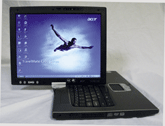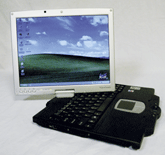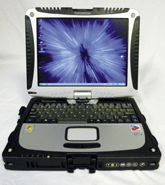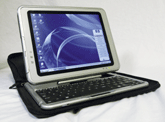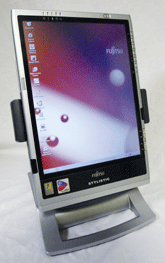The Tablet PC, launched with a lot of promise in 2003, was supposed to be a panacea for mobile workers, note-takers and business travelers.But the promise ran a bit ahead of the technology. Early tablet processors weren't fast enough to drive the ingenious applications designed for tablets, such as scribbling notes into a word processor or pasting voice clips into documents.Mobile users had to either put up with large, heavy batteries or take some other type of computer on cross-country flights.[IMGCAP(2)] The Intel Centrino chip has changed all that. Every system in this review has a Centrino, which runs fast without draining the battery.The GCN Lab reviewed standard notebook PCs just as the Centrino was coming out, and the first notebooks that incorporated it used far less power and generally ran faster than others. In the tablet format, the Centrino has really made a difference.The latest tablets have started to evolve a bit in their form factor. For example, pure slate-maker Motion Computing has made USB and snap-on keyboards optional instead of offering only a stylus. Acer, which at first backed the convertible-to-notebook tablet format, is making all its notebooks convertible to tablet by next year.Depending on how you count, this is the second or third generation of tablet PCs. Across the board, they're an impressive lot and are finally starting to live up to their promise.The Acer TravelMate C303XMi should have racing stripes. Not only is it the fastest tablet in this review, it also scored at the high end of most notebooks we have tested. It scored an astounding 6,304 on the lab's benchmark suite from Alterion Corp. of Conshohocken, Pa., more than 2,000 points higher than the closest competitor.[IMGCAP(3)] Alterion's benchmark is application-based, using Adobe Photoshop, PKZip and Microsoft Excel to push processors to the limit. That's particularly revealing with tablets because application use is where they formerly fell down. All the tablets did well this time, but the TravelMate blazed through the tests.It costs slightly more than most of the others, but what's packed inside more than makes up for the extra dollars. With a 1.7-GHz Centrino processor and a full gigabyte of RAM at a government price of $2,599, you get a great tablet value'even greater when you consider that it's convertible to notebook format.Our test TravelMate had a 14-inch screen, the largest in the review, perfect for tablet applications where more screen equals a bigger piece of working real estate.The disadvantages? That depends on what kind of mobile user you are. If you travel light, remember the TravelMate is about double the size of most other tablets in the review. I personally go for computing performance over small size, but not everyone agrees. If you do, then the TravelMate C303XMi is a perfect example of what a tablet can do when built right. It earns an A and a Reviewer's Choice designation.The HP Compaq TC1100 reverses the TravelMate's trade-off. HP has sacrificed some performance, though not much, in favor of a very small and usable form factor.The pure slate design comes packed in a canvas case that resembles a three-ring school binder. The tablet itself is very small, measuring less than an inch thick and 11 inches long by eight inches wide.It could handle all our tablet and ordinary test applications, scoring 4,243 on the benchmarks'slower than the Acer but more than fast enough for most users.[IMGCAP(4)] The test unit came with a keyboard that folds under the screen or can be used in an upright position, effectively turning the slate into a convertible notebook. It contributes almost no weight and when folded increases the thickness to barely more than an inch.The HP has a 1-GHz processor and 512M of RAM for $2,177, or $194 more for a removable DVD/CD-rewritable drive, which we highly recommend. It earns the second Reviewer's Choice designation and an A for mixing great performance with great portability.The Fujitsu Stylistic LifeBook ST5000 would be perfect for long trips and extensive Web surfing. At 12 inches long and 7 inches across, the screen forms a rectangle ideal for Web browsing.The $2,646 list price includes a 9-cell, high-capacity battery, longer and bigger than standard batteries. That price also buys a well-made docking station that automatically orients the display when you tilt it horizontally or vertically.The high-performance battery lasted four hours, 20 minutes, the second-longest run in the test, despite the large screen.The Stylistic scored 3,817 on the benchmarks and opened applications quickly. Our test unit had a 1-GHz Centrino processor and 512M of RAM.As a pure slate, it tended to run a little hot, but heat-absorbent felt on the back stayed comfortable. The only real flaw we could find was failure to dock properly with the extra battery, which adds about an inch to the length.The Stylistic earned a B+ in this review as a good example of a second-generation system.[IMGCAP(5)] The ViewSonic V1250 is a very portable convertible tablet, slightly larger than the HP but with a 12-inch instead of a 10-inch screen.Besides having a large screen for a portable, the V1250 had the best pen action in the review. Operation was smooth and accurate whenever we touched pen to screen in tablet mode.The V1250 scored a respectable 3,752 on the benchmarks. It came with a 1-GHz Centrino and 512M of RAM. Battery life, however, was the weakest of the review at one hour, 56 minutes.Detached from the docking port, the V1250 is extremely light and easy to carry. If you want a convertible tablet with a big screen and without unwieldiness, the V1250 is a great choice despite the short runtime. It earns a B.The rugged Panasonic Toughbook CF-18 departs from the usual ruggedness concept'durability at the cost of performance.With a 1.1-GHz processor and 256M of RAM, the Toughbook scored 4,059 on the benchmarks, faster than several of the non-rugged models.It's compact at 11 inches across and feels solid as a brick, but without the weight. The keyboard is very small, however, and even my average-sized fingers had some trouble.The compact size extended battery life amazingly. The Toughbook just kept running and running, even when we set it to average brightness with a movie playing in full-screen mode. It lasted a minute longer than five hours, the best performance in the review.[IMGCAP(6)] Even users who don't ordinarily work outdoors might want to consider ruggedness in the tablet world. A large screen that sits out front is far more exposed to damage than most notebook screens. A rugged system could mean longer hardware survivability in fieldwork.Ordinary office use probably can't justify the government price of $3,467. But if you do need the extra protection, the Toughbook CF-18 makes an excellent choice as a fine convertible tablet. It earned a B.The Motion Computing M1400 is the next generation of one of the first pure slates we tested. It has a simple docking station: You just slide the tablet into a plastic frame.Motion Computing has embraced peripherals that make the slate format a bit more functional. An available USB keyboard works great with the unit in the docking port, and a very nicely designed hardtop keyboard serves for the road.Our test system had a 1.1-GHz processor and 512M of RAM. The 12.1-inch display made using the device easy as a pure slate.But the M1400 did not perform as well as the other tablets. It scored only 2,868, making it the slowest in terms of application performance.The M1400 does have a big plus in price, however. It lists for $1,851 on Dell Inc.'s General Services Administration schedule.Although the M1400 is the slowest system of the review, it still performed adequately with our test applications. It earned a B- for this review and a Bang for the Buck designation.
Acer TravelMate C303XMi
Rick Steele
Panasonic Toughbook CF-18
Fujitsu Stylistic LifeBook ST5000

